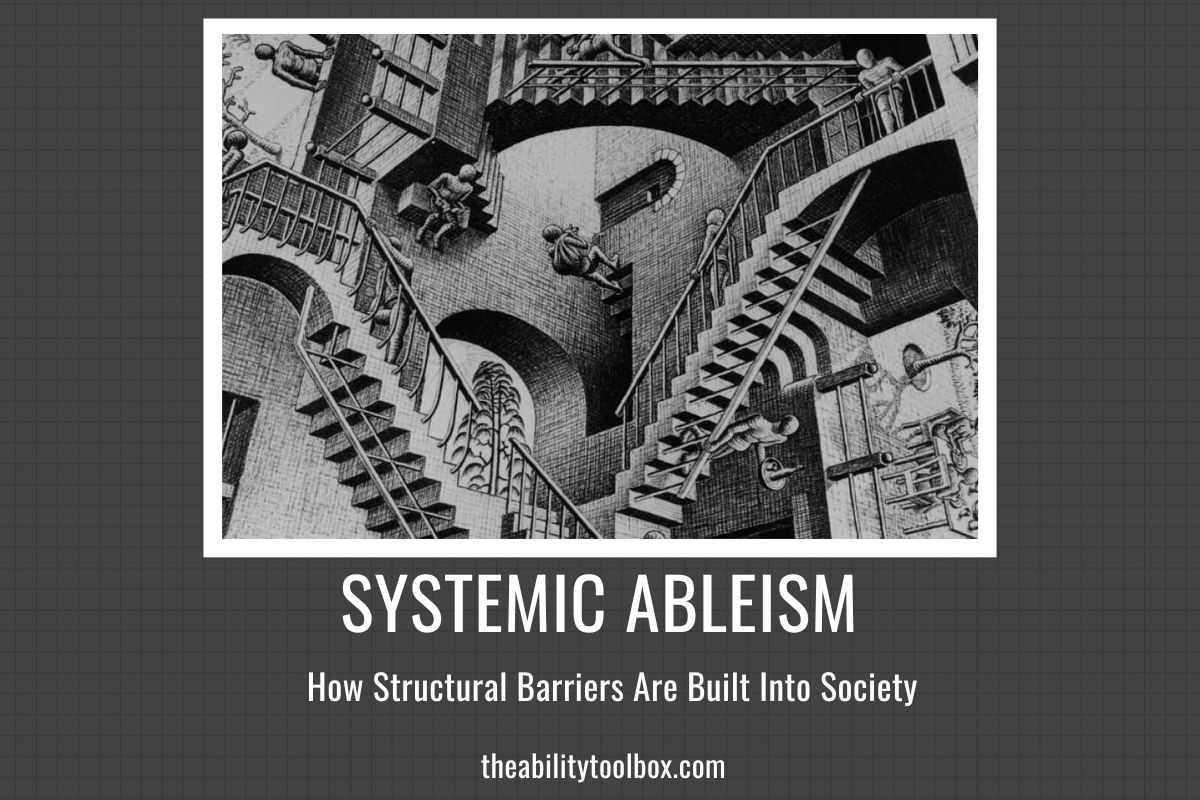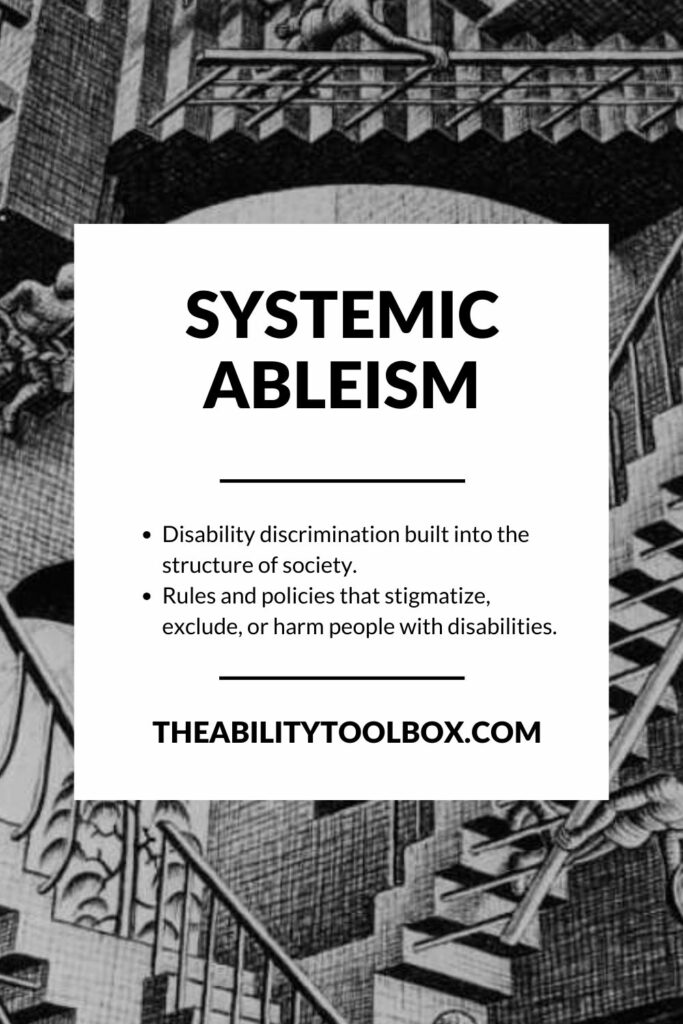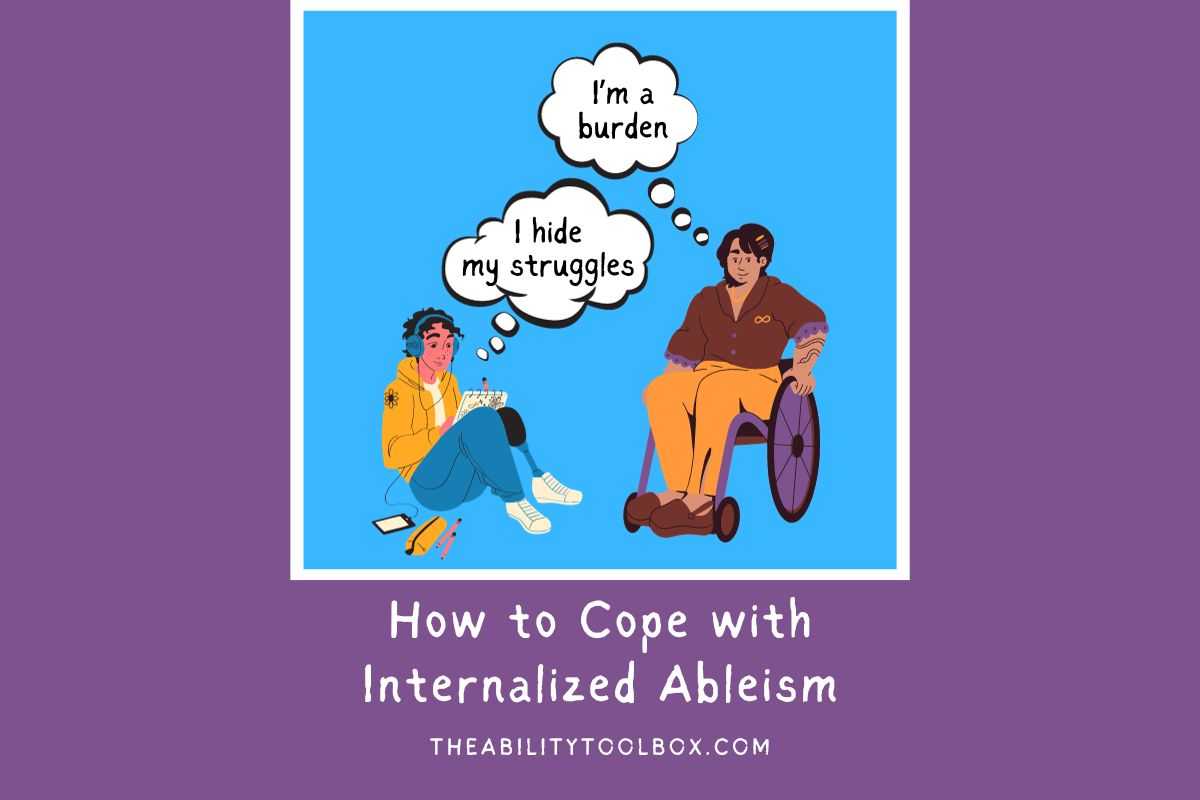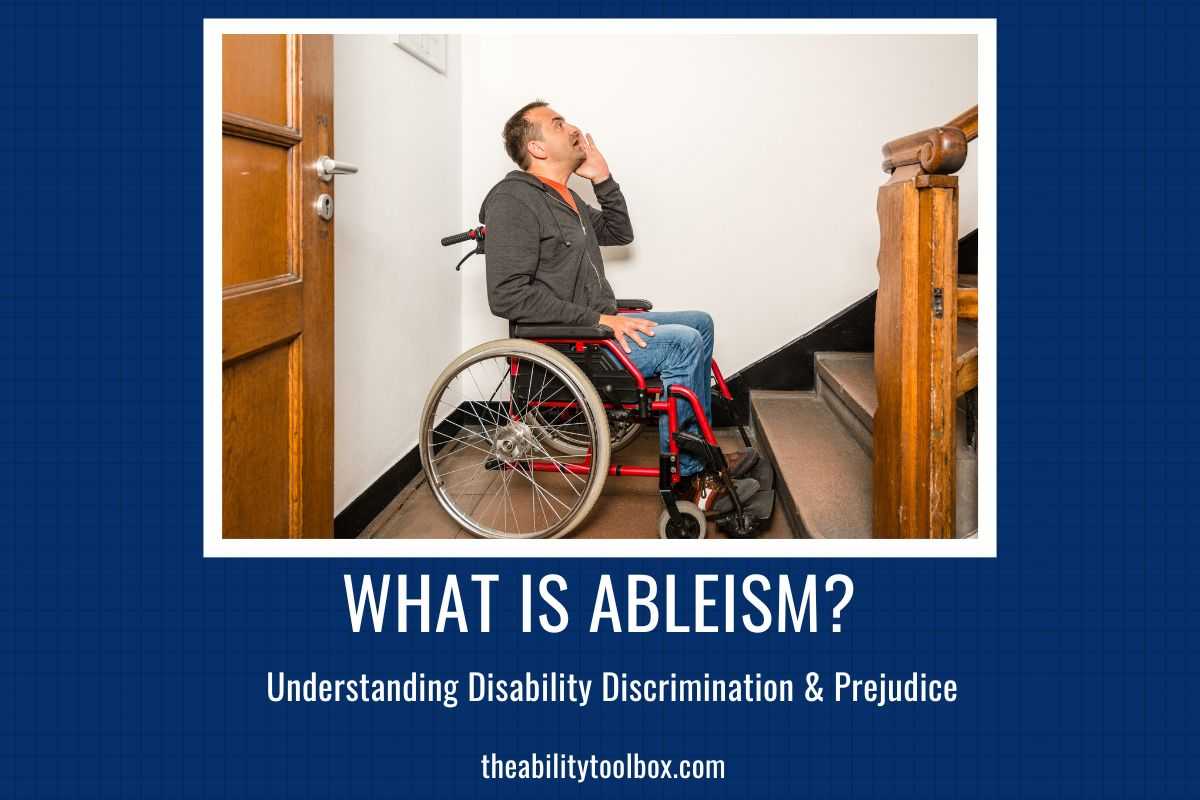
If you or someone you care about has a disability, you've probably quickly figured out that the world wasn't built with disabled people in mind. In fact, it often makes life harder for us in ways that could and should be fixed. This is systemic ableism — and here's what you need to know to understand and do something about it.
What is systemic ableism?
Systemic ableism is disability discrimination built into the structure of society. Systemic ableism is also known as institutional ableism or structural ableism. Where interpersonal ableism involves an individual discriminating against another person or group with disabilities, systemic ableism is found in companies and government agencies whose rules, policies, and procedures stigmatize, exclude, or harm people with disabilities. In some cases, this discrimination is intentional, while in others, it is an oversight or based on assumptions that people with disabilities would not be able to utilize a particular facility, program, and/or service.
The Connection Between Systemic Ableism and Other Systemic Biases
Since disability is intersectional, there is significant overlap between systemic ableism and systemic racism, sexism, and homophobia. People with disabilities who are also part of other marginalized groups — BIPOC, LGBTQ+, immigrants, low-income, etc. can face compounded stigmas.
The Roots of Systemic Ableism
Systemic ableism is rooted in the idea that disabled people have less value than abled people, so our lives don't matter. It is based on disability myths and stigmas, some of which date back hundreds or thousands of years. Systemic ableism perpetuates those biases in such a way that people tend to internalize them and accept them as the truth.
Examples of Systemic Ableism
Systemic ableism is all around us. It's so pervasive that we often accept it as “just the way things are.” To make change happen, we must learn to see systemic ableism and challenge it. Here are some examples of systemic ableism you may encounter every day.
Systemic Ableism in Public Buildings
Every time you see a step at a building entrance, it's an example of structural ableism. Ramps can be used by people who walk just as easily as steps, so why are steps the default and ramps, if present at all, often placed to the side or hidden from immediate view?
The Americans with Disabilities Act was passed in 1990 and requires that public places be accessible. However, many buildings are still inaccessible. The ADA is difficult to enforce — if a business refuses to comply, disabled people must file a complaint with the Department of Justice or file a lawsuit under one of the various state laws related to the ADA. Many countries have no laws like the ADA at all, so we're fortunate to some extent, but much more could and should be done to make the United States more accessible.
Systemic Ableism in Employment
Although employers are prohibited from discriminating against people with disabilities in the United States, such discrimination is still extremely common. Since employment discrimination is hard to prove, many disabled people are unemployed and trapped in poverty. Here are some examples of systemic ableism in employment.
Hiring Discrimination
Many people with visible disabilities have experienced having an employer be extremely interested in hiring them only to suddenly change their mind after the interview.
Employment-Linked Health Insurance
In the United States, health insurance is often linked to employment. This makes it difficult for people with disabilities and chronic illnesses to access healthcare if they can only work part-time, or forces them to work more hours than they can handle to keep their insurance.
Job Accommodations
Under the ADA, employers are required to provide reasonable accommodations to workers with disabilities. However, companies often avoid hiring disabled people or try to refuse accommodations out of fear that they will be expensive. Research demonstrates this is false — a recent survey conducted by the Job Accommodation Network found that half of all accommodations cost the businesses nothing, and another 43% had a one-time average cost of $300.
Return-to-Office Policies
Due to systemic barriers to transportation, housing, and healthcare, working from home is often the best solution for people with disabilities. Requiring employees to come to the office when a job can be done from home is inherently ableist. It puts immunosuppressed employees at unnecessary risk and disadvantages employees who are more productive in a home environment with their medical equipment on hand. In the vast majority of cases, remote workers save companies money, as they don't have to pay for office space.
Systemic Ableism in Social Services
There are numerous examples of institutional ableism in social services programs that are supposed to serve disabled and marginalized communities. However, many people are unaware that they exist. Here are a few you may not have considered.
Disability Benefits and Forced Poverty
Disability often forces people into poverty and makes getting out of it next to impossible. In most states, people with disabilities who receive Supplemental Security Income (SSI) and/or Medicaid are only allowed to have $2000 in resources, excluding their home and one car. If the person is married, not only do their spouse's income and resources count against their eligibility, but their combined maximum is $3000, not $4000. While there are some workarounds, such as ABLE accounts and special needs trusts, these draconian rules and limits often trap disabled people in poverty and effectively prevent them from getting married.
When you are poor and struggling just to survive, it's harder to advocate for yourself, find supportive doctors, and buy things that can make your life with a disability easier.
Ableist Caseworkers
The toxic culture of some social service agencies encourages caseworkers to treat recipients as potential scammers trying to take advantage of the system. Caseworkers are often given tremendous authority in determining the level of services a disabled client receives, even if their assessments conflict with evaluations from a medical professional. Recipients can file an appeal to get the services/care they were denied, but the process is arduous.
Inaccessible Homeless Shelters and Emergency Shelters
Many homeless shelters, domestic violence shelters, and emergency weather shelters are not wheelchair accessible and/or do not have accessible bathrooms and medical equipment such as Hoyer lifts and hospital/adjustable beds that people with significant mobility disabilities need. Staff at these facilities do not have the time or training needed to assist disabled shelter clients with their care needs. Therefore, people with disabilities have few options to escape an abusive partner or caregiver, or may have to go into a nursing home.
Abusive Guardianships
Britney Spears brought the issue of abusive guardianships into the public consciousness, but thousands of disabled people have suffered under guardianship. The system was created to help people with no ability to communicate to manage their financial affairs, such as someone in a coma or with severe dementia. However, many people who can communicate and express their wishes are forced into guardianships. Guardians have tremendous powers — they can take away their “protected person's” fundamental rights, including preventing them from seeing friends and family and stripping them of their right to vote.
Systemic Ableism in Healthcare
Healthcare is riddled with systemic ableism; it would take a book to discuss it in depth. Here are just a few examples to illustrate how difficult it can be to get proper medical care when you have a disability.
Ableist Doctors
Most medical schools do not teach students how to support patients with disabilities. As a result, doctors and other health care providers are often uncomfortable treating patients with disabilities, and frequently use disability slurs and ableist language such as “wheelchair-bound.” Doctors are often taught outdated and inaccurate information about conditions such as Down syndrome and cerebral palsy, leading them to paint these diagnoses in an unnecessarily tragic light. It's hard to respect people you consciously or subconsciously view as damaged goods because that's what you've been taught by society and even your medical training.
Some medical professionals engage in excessive gatekeeping around disability supports — for example, many refuse to assist patients who need disability parking permits, emotional support animal letters, and Social Security benefits based on ableist biases about who is “deserving” or “disabled enough.”
Gender and Anti-LGBTQ Bias
At the intersection of gender and disability, many healthcare providers are dismissive of debilitating chronic illness systems, especially in women, making it difficult to get a diagnosis and treatment. LGBTQ+ people with disabilities can face compounded struggles when trying to access gender-affirming care.
Abusive Institutions and Asylums
Historically, people with mental illnesses and other disabilities were frequently hidden away in asylums and institutions where they were subjected to abuse and neglect. Nursing homes and mental health treatment facilities, the modern equivalent, often aren’t much better. People with disabilities who want to receive care services in their homes and communities often face waiting lists and lack of support.
The Medicaid Institutional Bias
Various state Medicaid programs provide personal care assistance services to people with disabilities so they can dress, bathe, and maintain their homes. However, the availability of services varies greatly by state. Some have lengthy waiting lists, forcing people who could live independently with support into nursing homes. Some have fixed maximum hours of service/care that do not meet the needs of people with more severe physical and/or intellectual disabilities. Wages for care workers are extremely low in almost every state, and often pay less than even fast food, especially since the pandemic and inflation have caused other wages to increase.
Barriers to Mental Health Care
Many insurance companies and state Medicaid programs claim to provide parity in coverage of mental health services. However, many people seeking mental health services are effectively unable to access them due to long waiting lists/limited availability at mental health treatment centers, drug rehabilitation facilities, transitional homes, counseling services, etc.
Durable Medical Equipment Exclusions
Many health insurance plans categorically exclude coverage for durable medical equipment needed by people with disabilities. Commonly excluded items include hearing aids, limb prosthetics for running, and power wheelchairs that have an elevated seat or allow the user to stand. The Affordable Care Act failed to address these inequities, another example of systemic ableism.
Systemic Ableism in Housing
There is an extreme shortage of affordable, accessible housing for people with disabilities. Here are some examples of how structural ableism limits housing options for people with disabilities.
Low-Income Housing
Under the Fair Housing Act, new apartment complexes are required to contain some accessible units. However, such units can be difficult to find and afford.
Federal and state housing programs such as Section 8 provide vouchers that assist low-income tenants by paying a portion of their rent. The maximum payments are generally at the low end of market rate for the area. However, most accessible apartments are in newer buildings with rents at the higher end of market rate. While it is theoretically possible to get a higher maximum payment as a disability accommodation, it is extremely difficult, so many disabled Section 8 recipients are unable to find accessible housing.
Homeownership
In the private housing market, new homes with steps and multiple floors without an elevator are still the default. It's extremely difficult to find a wheelchair-accessible house, so many disabled people must undertake costly home remodeling or make as many improvements as they can on a budget.
Systemic Ableism in Transportation
If you're trying to go places with a physical disability, you'll quickly encounter barriers. Here are some examples of systemic ableism in transportation.
Public Transportation
Many people with disabilities are unable to drive and must rely on public transportation. In the United States, public transportation is required to be accessible to wheelchair users. However, people with more severe physical disabilities who cannot use fixed-route transportation must rely on paratransit, a system that is almost universally underfunded and inadequate. Paratransit users must request rides well in advance and often be picked up hours before their appointment so they can arrive on time.
Even when a disabled person can use regular fixed-route transportation, they often encounter delays, hostile bus drivers, subway stations with broken elevators, and other systemic problems that occur because transportation for disabled people is not a priority.
In most cities, rideshare services such as Uber and Lyft do not have any vehicles with ramps or lifts that can accommodate power wheelchairs. This leaves power wheelchair users who don’t have a van with no way to get around besides public transportation.
Rideshare drivers are required by law to transport people with mobility aids that can fit into a car trunk, as well as people with service dogs. However, both Uber and Lyft have been sued repeatedly for denying access to people with service dogs, and disabled riders on social media frequently report having Drivers cancel on them when they see their wheelchair or service dog.
Private Vehicles
When it comes to private transportation, there are no car companies that make a vehicle that is wheelchair accessible by default. All wheelchair-accessible vehicles must undergo a conversion process that ranges from $10,000-$30,000 on top of the cost of the vehicle itself. This cost is not covered by insurance, but can be covered by vocational rehabilitation services in some states. Still, the overall high cost makes private transportation systemically inaccessible to people with mobility disabilities.
Systemic Ableism in Education
My mother used to say that education was the one thing nobody could ever take away from you. She was right; education has been key to my success as a person with a severe physical disability. However, for me and the vast majority of other people with all types of disabilities, accessing equal education is fraught with barriers. Here are just a few examples of systemic ableism in education.
Inclusion and IEPs
The United States has required equal access to education for children with disabilities since IDEA became the law in the 1970s. However, services are underfunded, and children often end up in segregated classrooms when they should be included in the same classes as their typical peers. Parents must fight for their kids to be placed in inclusion classes and for IEPs to be properly implemented.
Gender Bias
Girls/women and those assigned female at birth often struggle with undiagnosed autism or ADHD for years because they are viewed as conditions that mostly affect men, and often present differently in women.
While girls go undiagnosed, boys are often treated as “bad seeds,” especially boys of color. Behaviors that should be viewed as signs of conditions such as ADHD are instead seen as indications that the boy is dangerous and has criminal tendencies.
The School-to-Prison Pipeline
Children with behavioral challenges are often subjected to seclusion and restraint, and can even be arrested and treated as criminals. Research shows that 85% of youth in juvenile detention facilities have learning and/or mental health disabilities.
Systemic Ableism in Policing and Justice
Some of the most deadly examples of systemic ableism can be found in the criminal justice system.
Mass Incarceration
People with disabilities, especially mental illnesses, often end up homeless and in frequent contact with the criminal justice system because of inadequate access to treatment and supportive housing. A 2022 study published in Health Affairs found that 66% of incarcerated people have disabilities, many of whom committed minor crimes and need mental health treatment, not incarceration.
Police Brutality
Did you know that half of people killed by the police have a disability? Police often aren't properly trained in how to safely de-escalate situations involving a person experiencing psychosis or an autistic person having a meltdown. However, training is only part of the solution. We must address implicit bias in law enforcement and the criminal justice system to end the killing and mass incarceration of people with mental health disabilities.
Systemic Ableism on the Internet
The internet has created many employment and social connection opportunities for the disability community, but it also contains its own forms of structural ableism, with more popping up as technology evolves. These include:
Inaccessible Websites
The Americans with Disabilities Act requires that all government websites and websites for businesses and organizations that serve the public be accessible. However, most websites are not accessible. Blind people often struggle to navigate sites using screen readers, and far too many online videos still lack captions for hard-of-hearing people. A 2023 study of the top 1 million websites found that they contain an average of 50 accessibility errors per page.
Biased Search Algorithms
Google and other search engines use algorithms to determine which websites appear at the top of search results. These algorithms often categorize disability-related articles as medical content even though they’re not, and then won't rank them well in search because they aren't written by doctors. This effectively silences peer experts and other disabled people who share our stories online.
Bias in AI Language Models
AI programs such as Chat GPT are trained on the words of people, and therefore can reflect the prejudices expressed in those words. According to a recent Penn State study, large language models exhibit learned disability bias, including assessing conversations as negative simply because they use disability-related terms. Medical AI language models have been found to include racist myths, creating added barriers for people of color with disabilities.
Online Trolls and Harassment
People with disabilities are frequently subjected to abuse by internet trolls. Too often, ableist harassment and comments are deemed acceptable by content moderators who do not understand that such behavior is comparable to racism and sexism.
How We Can End Systemic Ableism
Institutional ableism is deeply entrenched in our society, but we can change that. Here are some ways you can help.
Advocate for Structural Change
Vote for politicians and parties that support universal healthcare and robust services for people with disabilities. Get involved with disability advocacy to fight structural ableism and make your community more accessible and inclusive.
Do Your Part
Although ending systemic ableism requires societal change, our individual actions matter. We can choose whether we fight or perpetuate ableism within broken systems. People working within programs and organizations where there is institutional ableism can mitigate its impact through their actions and advocacy.
Ask any disabled or mentally ill person and they'll tell you about the doctor who dismissed their symptoms and the one who listened and helped. The caseworker who told them if they didn't shower daily and ate frozen dinners they could manage with 6 hours a day of care, and the one who fought for them to get the 12 hours a day they needed. The police officer who threw them on the ground and handcuffed them during a manic episode and the one who called a loved one to take them to the hospital. If you're a doctor, social worker, police officer, or anyone else working within the system, you can be the one who does the right thing.
Just because a system is biased, that does not give you an excuse to throw up your hands and say “There’s nothing I can do.” There is always something you can do, some small difference you can make. Be the change.
Have you encountered systemic ableism?
Share your experiences with our community in the comments.

Founder and Editor-in-Chief of The Ability Toolbox. I received my BA in English from Stanford University and MA in Clinical Psychology from Antioch University Los Angeles, and have worked in entertainment and health media for over 20 years. I also blog about traveling with a disability. As a wheelchair user with cerebral palsy, I am deeply committed to amplifying the voices of the disability community through writing and advocacy.








Start the discussion at community.theabilitytoolbox.com